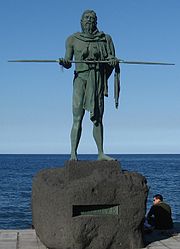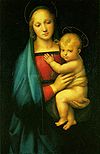- Virgin of Candelaria
-
Virgin of Candelaria Virgin of Candelaria, Saint Patron of the Canary Islands.[1] Honored in Roman Catholic Church Major shrine Basilica of Candelaria (Basílica de Nuestra Señora de la Candelaria), Tenerife (Spain) Feast August 14–15 (on Tenerife and the Canary Islands)[2] and on 2 February (also on this day in Tenerife, although minor festival). Attributes dark skin; baby in her right hand and a candle in her left hand Patronage Canary Islands as well as Tenerife; Medellín (Colombia), Puno (Peru), and Mayagüez (Puerto Rico) The cult of the Virgin of Candelaria or Our Lady of Candelaria (Virgen de Candelaria, Nuestra Señora de la Candelaria), popularly called La Morenita, celebrates an apparition of the Virgin Mary on the island of Tenerife, one of the Canary Islands (Spain). The center of worship is located in the city of Candelaria in Tenerife. She is depicted as a Black Madonna. Its main temple and Royal Basilica Marian Shrine of Our Lady of Candelaria (Basilica of Candelaria), is considered the main temple dedicated to the Virgin Mary in the Canary Islands.[3] She is the patron saint of the Canary Islands.[1] Her feast is celebrated on February 2 (Candlemas) and August 15, this patronal feast on Canary Islands.
Contents
Legend and appearance
According to a legend recorded by Alonso de Espinosa in 1594, a statue of the Virgin Mary, bearing a child in one hand and a green candle in the other (hence "Candelaria"), was discovered on the beach of Chimisay (Güímar) by two Guanche goatherds in 1392.[4] This occurred before the Castilian conquest of the island (the island was not fully conquered until 1496).
One of the shepherds tried to throw a stone at the statue, but his arm became paralyzed; the other tried to stab the statue with a knife but ended up stabbing himself.[1][4] The statue was taken by the local Guanche mencey, Acaymo, to the cueva de Chinguaro.
Later, was recognized by Antón, a Guanche who had been enslaved and converted to Christianity by the Castilians, as the Virgin Mary when he returned to Tenerife. He told the mencey of his conversion and the statue was thus venerated by the Guanches, who translated the statue to the cave of Achbinico (also known as San Blas - "Saint Blaise").[1] However, the statue was stolen and taken away to Lanzarote. It was brought back after the statue caused various events to occur on Lanzarote, but later returned to Tenerife.[4]
At first, aboriginals identified with the appearance of their goddess Chaxiraxi (the mother of the gods), but later the Christian conquerors explained that the image was the Virgin Mary.
Veneration
 Annual performance to honor Our Lady of Candelaria at Socorro Beach, Güímar. The men in fur capes represent the native Guanches.
Annual performance to honor Our Lady of Candelaria at Socorro Beach, Güímar. The men in fur capes represent the native Guanches.
The first mass was celebrated at Achbinico on February 2, 1497, and the Adelantado Alonso Fernández de Lugo ordered the construction of a hermitage there, but it was not built until 1526, during the rule of Pedro Fernández de Lugo.[5] This was the site of the Basilica of Our Lady of Candelaria.[4] The basilica was destroyed by fire and rebuilt in the 19th century.[4] The statue itself was lost when a tsunami carried it out to sea in 1826; the present statue is a copy by Fernando Estévez.[4] The image of the Virgin is dressed in rich robes of different colors and jewels.
She was declared patroness of the Canary Islands in 1559, by Clement VIII (and principal patroness in 1867).[1] Between October 1964 and January 1965, the Diocese of Tenerife conducted the largest pilgrimage took place in the history of the Canary Islands, the transfer of the image of the Virgin of Candelaria (Saint Patron of Canary Islands) for all municipalities and cities island of Tenerife.
She is widely venerated in South America and the Caribbean, where she is the patroness of Medellín (Colombia), Puno (Peru), and Mayagüez (Puerto Rico) (which was founded as Nuestra Señora de la Candelaria de Mayagüez). There is an image of her at San Antonio, Texas, center of an isleño community, as well. In the Caribbean African diaspora religion Santería, the Virgin of Candelaria was syncretised with the Yoruba goddess called by the names Iansan and Oya. In coastal Brazil Candelaria, called Nossa Senhora das Candeias in Portuguese, is syncretised with the Yoruba Goddess Oshun.
Sanctuary
 Basílica of Candelaria (Tenerife)
Basílica of Candelaria (Tenerife)
The Sanctuary includes Candelaria Basilica of the Virgin of Candelaria and the Holy Cave Achbinico (the latter was the first of its worship, along with Cave Chinguaro).
Basilica of Candelaria
The current basilica dates back of 1959 and it was constructed on a former hermitage. His your discharge stands out toast belfry, to his your feet one finds the Plaza de la Patrona de Canarias. Since the image of the Virgin was appearing in beach of Chimisay, around 1392, the first great Sanctuary to the Virgin of Candelaria was the constructed one in 1668. Later with the increase of the peregrinations of the devout ones, there was created the need to construct a bigger temple (the current basilica), which has capacity for 5.000 persons.
Cueva de Achbinico
Also so called Cave of San Blas, it was the first Christian temple of the Canaries, in this place the original inhabitants of the Canary Isles worshiped the Virgin of Candelaria. This cave is behind Candelaria's Basilica and is visited by pilgrims, which are in the habit of taking and leaving flushed candles and doing requests to the Virgin. Inside the cave there is a reply in bronze of the Virgin of Candelaria. Achbinico's cave has great importance not only for religious, but also historical reasons, since in the cave baptisms of guanches have been performed.
The strange letters in the original carving of the Virgin
Moreover, in the carved drapery of the Virgin of Candelaria original existed some strange letters whose meaning is still unknown. These were:
- Girdle in the neck: ETIEPESEPMERI
- On the left sleeve: LPVRINENIPEPNEIFANT
- At the bottom of the robe: EAFM IPNINI FMEAREI
- In the belt: NARMPRLMOTARE
- In the mantle, in the right arm: OLM INRANFR TAEBNPEM Reven NVINAPIMLIFINIPI NIPIAN
- At the edge of the left hand: EVPMIRNA ENVPMTI EPNMPIR VRVIVINRN APVI MERI PIVNIAN NTRHN
- On the back in the queue: NBIMEI ANNEIPERFMIVIFVE
Syncretism
The Virgin of Candelaria is identified or syncretized with other holy entities from other religions:[6]
- In Guanche mythology, the Virgin of Candelaria was identified Chaxiraxi, and her son Chijoraji.
- In Cuban Santería, the Virgin of Candelaria is identified with Oyá.
- In Brazilian Candomblé, the Virgin of Candelaria is identified with Oshun.
- In the Hindu religion, the Virgin of Candelaria is Kali, the black patron goddess of the city of Calcutta in India.
- For Andean religions, this dedication is linked to the cult to the Pachamama (Mother Earth).
Gallery
See also
General articles
Overview of Mariology •
Veneration of the Blessed Virgin • History of MariologyExpressions of devotion
Art • Hymns • Music • ArchitectureSpecific articles
Apparitions • Saints • Popes • Societies • Hearts of Jesus & Mary • Consecration to Mary- Basilica of Candelaria
- Cristo de La Laguna
- Catedral Nuestra Señora de la Candelaria
- es:Virgen de la Candelaria (Islas Canarias) (Spanish Wikipedia)
References
- ^ a b c d e "Virgen De Candelaria - Islas Canarias". Mercaba.org. http://www.mercaba.org/MEDITACION/Maria/23%20Candelaria/virgen.htm. Retrieved 2010-08-23.
- ^ "Tenerife Festivals". Whattenerife.com. http://www.whattenerife.com/festival-tenerife.html. Retrieved 2010-08-23.
- ^ "in Spanish only". Eldia.es. 2009-08-05. http://www.eldia.es/2009-08-05/SUR/2-Candelaria-pide-siete-cabildos-participen-fiestas-agosto.htm. Retrieved 2010-08-23.
- ^ a b c d e f "Diva International.The Black Madonna : Virgin of Candelaria". Divainternational.ch. http://www.divainternational.ch/spip.php?article146. Retrieved 2010-08-23.
- ^ "Historia:docs:Milagros Virgen Candelaria". Mgar.net. http://www.mgar.net/docs/candelar.htm. Retrieved 2010-08-23.
- ^ "Virgen de Candelaria, syncretism". Saadaya.blogspot.com. 2004-02-27. http://saadaya.blogspot.com/2007/01/virgen-de-candelaria.html. Retrieved 2010-08-23.
External links
- Official Website of the Dominicans of the Basilica of Candelaria
- Virgen de Candelaria (Spanish)
- The Black Madonna: Virgin of Candelaria
- Virgin of Candelaria Festival at WN
History Guanches · Pre-colonial times · Treaty of Alcáçovas · First Battle of Acentejo · Battle of Aguere · Second Battle of Acentejo · Battle of Santa Cruz de Tenerife (1657) · Battle of Santa Cruz de Tenerife (1797) · Spanish transition · Autonomous communityLanguages Mythology Sports Bola canaria · Canarian wrestling · Juego del Palo · Salto del pastor · Open Lanzarote Island · Open Costa AdejeCuisine Almogrote · Canarian arepa · Canarian wrinkly potatoes · Gofio · Malvasia · Majorero · Miel de palma · Mojo · Pasteles · Ropa vieja · Sancocho · Sangria · Tropical beer · WinesMusical instruments Traditions Carnival of Santa Cruz de Tenerife · Carnival of Las Palmas · Bajada (festival) · Cavalcade of Magi · Holy Week · Virgin of Candelaria · Cristo de La Laguna · AkelarreSymbols places of the Canary Islands CategoryCategories:- Marian apparitions
- Canarian culture
- Tenerife
- Canary Islands
- Mayagüez, Puerto Rico
Wikimedia Foundation. 2010.









